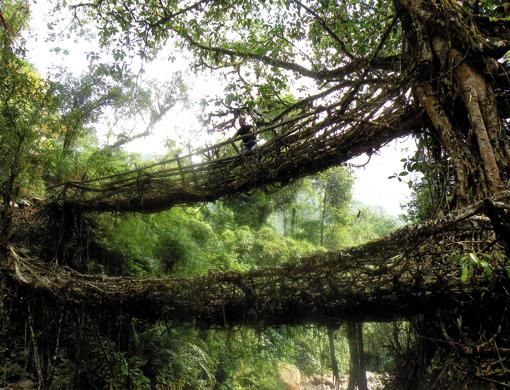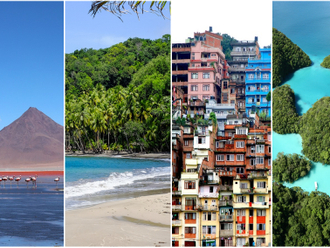I was on a plateau in the Khasi and Jaintia hills in a less-explored part of North East India. If I had an altimeter, it would have read 6,000 feet above sea level. I had stopped my car to admire the spectacular natural beauty of the place and was sure I could spend hours here and still not have enough of it. Admiring the verdant nature on a crisp, cool morning can be truly exhilarating. But I could not afford to spend too much time in reverie. I was in search of a marvel called a root bridge, apparently the only one of its kind in the world, and was keen to get there as early as I could.
I started my car, softly depressed the accelerator and Shillong, the capital of Meghalaya, once called 'The Scotland of the East', began to recede into the distance. The thin blanket of mist that had enveloped the area in the night was now rising feebly, and the 57-kilometre highway that snaked through the hillocks began to acquire an ethereal glow.
The road led to Cherrapunjee, which is considered the wettest place in the world. On my left were deep gorges, dense with forest, while on my right were pine-covered grassy slopes. As the road wound down from the plateau of Shillong, a panoramic vista began to open out before me. At one point, the plains of Bangladesh came into view in the distance gleaming with countless streams and water bodies.
My destination was the Cherrapunjee Holiday Resort in Laitkynsew village. It was to act as my base camp from where I would set off in my search for the root bridge. A narrow road broke off from the main highway and a small yellow board indicated that Cherra Resort was 15km away.
Much of the area was still in relative darkness as the sun's rays struggled to pierce the forest's thick canopy. Greenery was everywhere the rocks were covered with moss, ferns grew in abundance and plants thrived thanks to the record rainfall of the area.
It was around 9am when I reached the resort, which is perched on the edge of a mountain overlooking Bangladesh. After a hasty check-in, I decided to hit the road, keen not to waste time, because the sun sets pretty early in the eastern skies.
After quickly memorising the hand-drawn map given to me by Dennis Rayan, the ebullient owner of the resort, I shoved it into my rucksack and headed for the village where I was supposed to meet my guide named Nightstar.
Young Nightstar seemed to be having a great time with his friends at the local tea stall and was a trifle reluctant to leave them and trudge off into the forest with a stranger. But with a little cajoling, he jumped off his comfortable perch and agreed to take me to the root bridge. We soon became good friends and I learnt that during the tourist season, Nightstar makes a tidy income taking people around the Meghalaya forests. Off-season, he collects bay leaves from the forest. The leaves are in demand by chefs to add fragance and flavour to dishes and Nightstar makes a good sum selling them in the market.
He led me down a flight of winding steps through a little village square where people who were busy selling things or sipping tea by the wayside hailed us with a cheerful "hello, hello". Apart from the friendly nature of the people, what struck me as amazing was the cleanliness of the village. Unbelievably, there was no litter anywhere. The path was lined by beds of colourful flowers. Interestingly, almost every house had a bird cage with a bird or a few birds in it. "Are they substitutes for doorbells?" I asked Nightstar. "They could be," he laughed.
Soon, the path began to descend rather steeply and at one point it dropped down the sheer face of the mountain. The first signs of vertigo began to take hold and I had to stop for a few minutes to divert my mind from the height and overcome the awful swaying feeling. Fortunately, butterflies came to my rescue. A large, fantastically coloured butterfly posed delicately on a flower and I promptly fished out my camera and went trigger-happy.
I sat for a moment to catch my breath and watch a spider spin its web. "The first time I came here, I was also panting like you," Nightstar said. After a sip of water, we continued downhill into the valley, which is encircled by mountains. Small and large waterfalls cascade off the mountain faces, the sound and the view offering a feast for the senses.
After a descent of about 500 metres, the village of Nongthymmai burst into view. For a city-bred tourist, the village is quaint and unusual. Old men sat around in little groups smoking pipes and staring at passersby, children framed themselves against barless windows waving and smiling at tourists and colourful butterflies flitted around in a riot of airborn colour. It was orange season, and the heady scent of the citrus fruits and leaves left me invigorated.
The path became much easier and, as I was breathing in the fresh air, the soft gurgle of water filled the air an indication that there was a river not too far away. We turned a corner and there it was a steel rope bridge swaying invitingly over one of the most pristine rivers I have ever seen. So crystal clear was the water that every pebble and rock beneath the surface was clearly visible. The river was dotted with small blue pools, each more inviting that the next.
A quick glance at Rayan's map indicated there were some great ones further ahead so, putting away thoughts of diving into them for the time being, I fell in line behind Nighstar and began trekking deeper into the forest once again.
Our movements seemed to have stirred a few butterflies, which were feasting on the nectar of the abundant flowers. Red, green and blue butteflies in almost every shade were fluttering around and I dug into my rucksack once again for my camera. I was busy shooting when Nightstar pointed out that we were hardly ten minutes away from what is perhaps the only double-deck root bridge in the world.
The bridge lies in the village of Nongriate. A little donation box is placed a few metres from the bridge which reads 'Peace to you all who want to drop your gift in the box as a donation for the improvement of root bridges and footpaths'. A nearby signboard pointed in the direction of the bridge. At last, I reached the reward of my sweat and labour: the rare twin-deck root bridge. Stacked one above the other, they span a stream that is 20 metres wide. Of course, it does not have the clean lines of a man-made bridge, but it is awesome nevertheless. It is gnarled, ancient and a bio-engineering marvel a product of the Indian rubber tree. Apparently, it takes 20-25 years to form and can last up to a few hundred years.
These trees are 'trained' to form these marvels and can withstand enormous weight. Some of these bridges are said to be up to 30 metres in length. They can weather torrential thunderstorms and have to, considering it rains an average of 470 inches every year. (In 1974, the total rainfall recorded was 1,000 inches!)
After the inevitable happy snapping, I decided to head for the pools marked on the map. About 20 minutes walk away from the twin bridges are some of the most spectacular pools in the region. A plunge into the inviting cool blue water reveals white, yellow and dark blue butterflies feeding on the minerals oozing from the wet rocks.
After a tiring day's walk, the pools offered the best form of relaxation. Chirping birds, gurgling water, colourful insects, cold water... what more could one ask for?
The hour needle of my watch seemed to break into a trot and the cooling rays of the sun reminded me it was time to break my reverie again. I had to make my return trip and it was not going to be easy I was at 200 metres above sea level and my resort at 900 metres above sea level. There were many steps to climb before I could curl up in my comfortable bed.
With Nightstar leading the way once more, we started our climb back to the base camp and I returned feeling utterly fulfilled.













